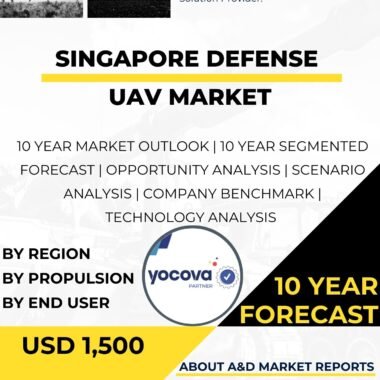Description
The defense Unmanned Aerial Vehicle (UAV) market in Japan has witnessed significant growth and strategic importance in recent years due to the nation’s focus on enhancing its defense capabilities and addressing security challenges in the Indo-Pacific region. UAVs, commonly known as drones, have become essential assets for military forces worldwide, offering a wide range of applications that include reconnaissance, surveillance, intelligence gathering, target acquisition, and strike capabilities.
As Japan faces evolving global security threats and regional tensions, the demand for advanced defense UAV technologies has grown. These unmanned aerial platforms provide unique advantages, including the ability to operate in contested or hazardous environments, perform long-endurance missions, and conduct operations with reduced risk to human personnel.
The Japan Self-Defense Forces (JSDF) have increasingly adopted UAVs across various branches, including the Ground Self-Defense Force (GSDF), Maritime Self-Defense Force (MSDF), and Air Self-Defense Force (ASDF). These UAVs play a critical role in enhancing situational awareness, intelligence collection, and overall operational effectiveness.
One of the primary applications of defense UAVs in Japan is in reconnaissance and surveillance missions. UAVs equipped with advanced sensors, cameras, and imaging systems provide real-time data and imagery, enabling the JSDF to gather critical intelligence and monitor potential threats across various terrains and environments.
Moreover, defense UAVs are also used for target acquisition and identification, facilitating the precise and effective engagement of hostile targets. Armed UAVs, commonly known as Unmanned Combat Aerial Vehicles (UCAVs), offer the JSDF the capability to conduct precision strikes on enemy positions while reducing the risk to manned aircraft and personnel.
In addition to combat roles, UAVs are utilized for search and rescue operations, disaster response, and humanitarian missions. Their ability to access hard-to-reach areas and provide aerial views of disaster-stricken regions makes them valuable tools for supporting civil authorities during natural disasters and emergencies.
As Japan focuses on indigenous defense capabilities, the domestic production and development of defense UAV technologies have grown substantially. Collaborations between the government, defense industry, and research institutions have fostered innovation, leading to the creation of advanced UAV solutions tailored to Japan’s specific defense requirements.
Additionally, Japan’s alliance with the United States has facilitated access to advanced UAV technologies and expertise. This collaboration strengthens Japan’s defense capabilities and contributes to regional security and stability.
The defense UAV market in Japan also benefits from advancements in commercial drone technologies. Many features from commercial drones, such as miniaturization, extended flight times, and advanced data processing capabilities, have found applications in defense UAVs, leading to increased performance and cost-effectiveness.
However, the defense UAV market in Japan faces challenges related to regulations, cybersecurity, and human-machine interaction. UAV operations in civilian airspace must adhere to strict regulations to ensure safety and prevent potential incidents.
Ensuring the cybersecurity of defense UAVs is crucial to prevent potential cyber threats and attacks on these unmanned platforms, which may compromise sensitive data and disrupt military operations.
Moreover, enhancing human-machine interaction and training is essential for operators to effectively control and manage UAV missions. The JSDF must invest in training programs to equip personnel with the necessary skills to operate UAVs efficiently and make informed decisions during missions.
In conclusion, the defense UAV market in Japan has witnessed significant growth and strategic importance, driven by the nation’s focus on enhancing its defense capabilities and addressing security challenges in the Indo-Pacific region. Defense UAVs provide critical capabilities in reconnaissance, surveillance, intelligence gathering, target acquisition, and strike operations, making them integral to the Japan Self-Defense Forces (JSDF). The collaboration between the government, defense industry, and research institutions, as well as international partnerships with allied nations, fosters innovation and contributes to the growth of the domestic defense UAV market. Challenges related to regulations, cybersecurity, and human-machine interaction must be addressed to further enhance Japan’s defense capabilities and ensure its ability to maintain a reliable and high-performance defense force, contributing to the modernization and effectiveness of the Japan Self-Defense Forces. With its strategic focus on modernizing its defense forces, Japan remains committed to leveraging advanced UAV technologies to enhance its defense capabilities and contribute to regional and global security.




